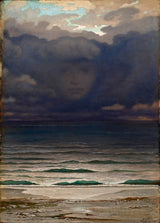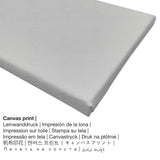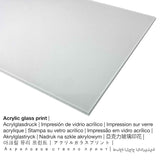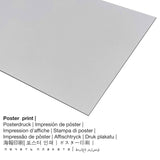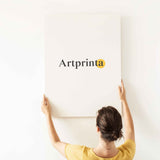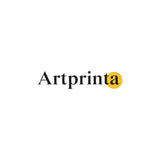Elihu Vedder, 1870 - Հիշողություն - կերպարվեստի տպագրություն
Հարկերը ներառված են: Առաքումը հաշվարկված է է Checkout:
Այս արվեստի արտադրանքի մանրամասները
In 1870 Elihu Vedder made this piece of art. The artpiece has the following size: 20 5/16 × 14 3/4 դյույմ (51,59 × 37,47 սմ) և ներկվել է տեխնիկայով յուղ կարմրափայտ ծառի վահանակի վրա. Ավելին, արվեստի գործը կազմում է հավաքածուի մի մասը Լոս Անջելեսի County Museum of Art, which is the largest art museum in the western United States, with a collection of more than 142.000 objects that illuminate 6.000 years of artistic expression across the globe. We are glad to reference that this հասարակական տիրույթ artpiece is being included with courtesy of Los Angeles County Museum of Art (www.lacma.org).: . What is more, the alignment of the digital reproduction is in դիմանկար ֆորմատ հարաբերակցությամբ 1: 1.4, Ինչը նշանակում է, որ երկարությունը 29%-ով ավելի կարճ է, քան լայնությունը.
Ապրանքի նյութեր, որոնցից կարող են ընտրել մեր հաճախորդները
Մենք առաջարկում ենք մի շարք տարբեր չափերի և նյութերի յուրաքանչյուր ապրանքի համար: Մենք թույլ ենք տալիս ընտրել հետևյալ տարբերակներից.
- Ակրիլային ապակու տպագրություն. An print on acrylic glass, which is often referenced as a UV print on plexiglass, transforms your favorite original work of art into brilliant décor. Your work of art is being custom-made with the help of modern UV direct printing technology. This creates rich and sharp color shades.
- Պաստառի տպագրություն (կտավի նյութ). A poster print is a printed sheet of canvas with a granular structure on the surface, which reminds the original artwork. It is suited for putting your art copy with the help of a customized frame. Please keep in mind, that depending on the absolute size of the poster we add a white margin of something between 2-6cm around the artwork, which facilitates the framing with your custom frame.
- Ալյումինե դիբոնդ տպագիր (մետաղ). An Aluminium Dibond print is a material with an impressive depth effect. Its non-reflective surface make a contemporary look. For the Direct Aluminium Dibond option, we print the favorite artwork right onto the surface of the white-primed aluminum composite. Colors are vivid and luminous in the highest definition, details of the print are crisp and clear, and you can literally notice the matte appearance of the art print surface.
- Կտավ: The UV printed canvas material mounted on a wood frame. It creates the extra look of three dimensionality. The canvas makes a cosy and comfy feeling. How do I hang a canvas print on my wall? The advantage of canvas prints is that they are relatively low in weight, which means that it is easy and straightforward to hang up the Canvas print without any wall-mounts. Canvas prints are suitable for any type of wall.
Կարեւոր տեղեկություններ: We try all that we can in order to depict our products as accurate as possible and to exhibit them visually on the respective product detail pages. Still, the pigments of the printing material, as well as the print result might differ slightly from the presentation on your device's screen. Depending on your screen settings and the quality of the surface, not all colors are printed one hundret percent realistically. Since our fine art prints are processed and printed manually, there might as well be slight variations in the motif's exact position and the size.
Հոդվածի կառուցվածքային տեղեկատվություն
| Ապրանքի դասակարգում. | կերպարվեստի տպագրություն |
| Վերարտադրման մեթոդ. | թվային վերարտադրություն |
| Արտադրության եղանակը. | Ուլտրամանուշակագույն ուղիղ տպագրություն (թվային տպագրություն) |
| Production: | պատրաստված է Գերմանիայում |
| Ֆոնդային տեսակը: | պահանջով |
| Արտադրանքի օգտագործման: | տան ձևավորում, պատերի ձևավորում |
| Կողմնորոշում: | դիմանկարի ձևաչափ |
| Առումով հարաբերակցությունը: | 1: 1.4 երկարությամբ լայնությամբ |
| Պատկերի հարաբերակցության իմաստը. | երկարությունը 29%-ով ավելի կարճ է, քան լայնությունը |
| Հասանելի արտադրանքի նյութեր. | մետաղական տպագրություն (ալյումինե դիբոնդ), ակրիլային ապակու տպագրություն (իսկական ապակու ծածկով), պաստառի տպագրություն (կտավ թուղթ), կտավի տպագրություն |
| Կտավ պատգարակի շրջանակի վրա (կտավ տպագրություն). | 50x70 սմ - 20x28", 100x140 սմ - 39x55" |
| Ակրիլային ապակու տպագրություն (իսկական ապակու ծածկույթով). | 50x70 սմ - 20x28", 100x140 սմ - 39x55" |
| Պաստառի տպագրության (կտավ թղթի) չափի տարբերակներ. | 50x70 սմ - 20x28 դյույմ |
| Dibond print (ալյումինե նյութ) տարբերակներ. | 50x70 սմ - 20x28", 100x140 սմ - 39x55" |
| Արվեստի կրկնօրինակի շրջանակավորում. | Խնդրում ենք նկատի ունենալ, որ այս արտ տպագրությունը շրջանակ չունի |
Կառուցվածքային արվեստի գործի մասին տեղեկատվություն
| Նկարի անվանումը. | "Memory" |
| Դասակարգում: | Ներկում |
| Արվեստի դասակարգում. | Ժամանակակից արվեստի |
| Ժամանակավոր դասակարգում: | 19th - րդ դար |
| Ստեղծվել է տարում. | 1870 |
| Արվեստի ստեղծագործության մոտավոր տարիքը. | ավելի քան 150 տարեկան |
| Նկարված է. | յուղ կարմրափայտ ծառի վահանակի վրա |
| Բնօրինակ արվեստի գործի չափը. | 20 5/16 × 14 3/4 դյույմ (51,59 × 37,47 սմ) |
| Ցուցադրված է. | Լոս Անջելեսի County Museum of Art |
| Թանգարանի գտնվելու վայրը. | Լոս Անջելես, Կալիֆորնիա, Ամերիկայի Միացյալ Նահանգներ |
| կայք: | Լոս Անջելեսի County Museum of Art |
| Լիցենզիայի տեսակը: | հասարակական տիրույթ |
| Քաղաքավարությամբ | Լոս Անջելեսի շրջանի արվեստի թանգարան (www.lacma.org) |
Նկարչի մանրամասները
| Artist: | Էլիհու Վեդդեր |
| Լրացուցիչ անուններ. | Vedder, Veder Elihu, vedder elihus, Elihu Vedder, e. vedder, Vedder Elihu |
| Նկարչի սեռը. | արական |
| Նկարչի ազգությունը. | ամերիկյան |
| Մասնագիտություններ. | բանաստեղծ, նկարիչ |
| Ծագման երկիր: | Միացյալ Նահանգներ |
| Նկարչի դասակարգումը. | ժամանակակից նկարիչ |
| Մահվան տարիքը. | 87 տարի |
| Ծննդյան տարին: | 1836 |
| Ծննդավայր: | Նյու Յորք Սիթի, Նյու Յորք նահանգ, Միացյալ Նահանգներ |
| մահացել է: | 1923 |
| Մահացած (վայրում): | Հռոմ, Հռոմի նահանգ, Լացիո, Իտալիա |
© Copyright of, www.artprinta.com (Artprinta)
Original artwork information as provided from Los Angeles County Museum of Art (© - Լոս Անջելեսի շրջանի արվեստի թանգարանի կողմից - Լոս Անջելեսի County Museum of Art)
Notes from the Curator:
Memory is one of Vedder’s most symbolic paintings. Although it at first appears to be a straightforward nocturnal view of the beach and ocean, upon close scrutiny one sees a faint human face emerge in the cloudy sky. Similar images of a floating head appear in a group of Vedder’s drawings from the late 1860s. Later he would be fascinated by the related classical motif of the head of Medusa. The theme of floating and severed heads was popular with the English Pre-Raphaelites, and at the end of the century it became a characteristic motif of the symbolists. Artists used such imagery to suggest states of mind and ideas of a personal nature rather than to describe the material world.
The art historian Regina Soria has identified two of the artist’s drawings as bases for the museum’s painting: The Face in the Clouds, 1866 (Wunderlich & Co., New York, as of 1987), which was illustrated in Vedder’s autobiography The Digressions of V. (p. 287), and a small drawing done the next year with the title Memory inscribed on its original mat (LACMA, see illustration).
As the 1867 drawing was executed on March 19, the birthday of Carrie Rosekrans, Vedder’s fiancée at that time, it has been assumed that the head in the two drawings and the oil painting was that of Rosekrans. If the drawings were intended to be portraits of Rosekrans, they would have had to have been done from memory for she was not with Vedder at the times of their execution. Actually, it is difficult to ascertain either the sex or the age of the face in any of the three.
The head may be that of a child. When Vedder painted Memory, Rosekrans was pregnant with their first child, and some seven years later he was commissioned by a Mr. and Mrs. J. R. Dumaresq to make a similar painting using the face of their recently deceased son. Will South has noted that at least one contemporary of Vedder’s, English critic William Davies, referred to the head in the drawing Memory with the neuter "it" (Art Pictorial and Industrial: An Illustrated Magazine 1 [September 1870]: 49).
In none of Vedder’s own writings does he suggest a particular person or type as the model for the floating head. Perhaps the ambiguity of the sex and age of the head was intentional, for such imagery accords well with the artist’s lifelong fascination with imaginative subjects and his enthusiasm for a sense of mystery.
According to the artist’s annotation of the 1866 drawing The Face in the Clouds, he was inspired to create such a meditative image by Alfred Lord Tennyson’s poem, "Break, Break, Break" (published 1842), in which the poet contemplates the sea and broods over the memory of lost ones. In Vedder’s painting the insubstantial, miragelike face, in contrast to the sharp reality of the shore and waves, suggests the transitory nature of life and the dreamlike quality of memory. In its quiet, mysterious mood the painting is quite evocative. The mauve palette and spectral quality of the night lighting also place Memory within the formal and conceptual tenets of late nineteenth-century symbolism. In fact, Memory ranks as one of the earliest symbolist images by an American.
Notes from the Contributor: Painting by Elihu Vedder (Museum: Los Angeles County Museum of Art)

